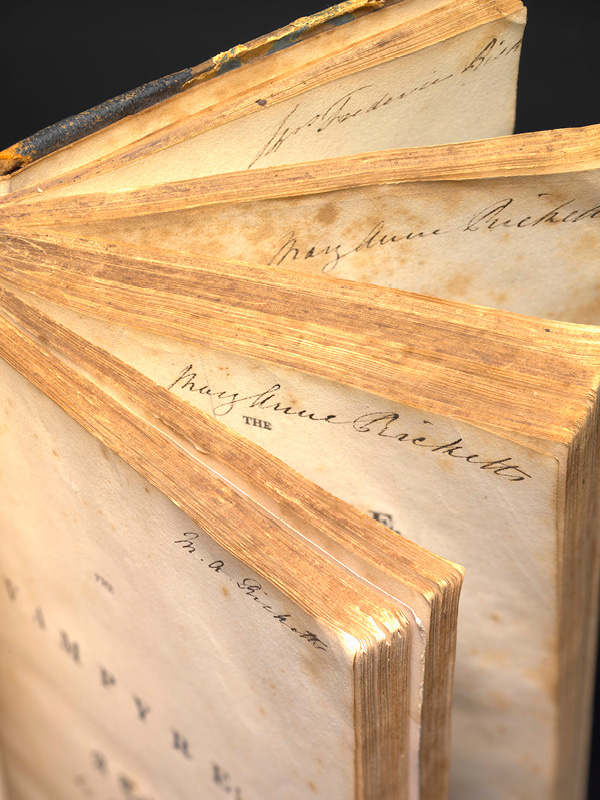During a recent appraisal of the Fryer Library book collection, we chanced upon a first edition of a rare book from 1819 with a very interesting history.
Enjoy this story about how some rainy weather inspired the creation of literary masterpieces and discover how a copy of one of these items found its way to the Fryer Library.
Rain leads to literary masterpieces
In 1816 the English poet Lord Byron rented the Villa Diodati near Geneva in Switzerland. Staying with him were fellow poets Percy Shelley and Mary Godwin (who were soon to be married), Mary’s stepsister Claire Clairmont, as well as Byron’s personal physician, John Polidori.
Forced to stay indoors for several days because of constant heavy rain, the group passed an evening by reading ghost stories to each other. So inspired were they by these stories that they decided to each write their own – with astonishing results.
Frankenstein
While Byron produced the little-known Fragment of a Novel, published as a postscript to his Mazeppa (1819), Mary Shelley wrote a story that is regarded as a literary masterpiece to this day. This was Frankenstein (Frankenstein, or the Modern Prometheus by its full title) published in 1818.
A vampire in the library
The Fryer Library does not hold a first edition of Frankenstein, but we did come across, bound together with other early 19th century works, a copy of the other significant book that had its genesis at Villa Diodati that night, a first edition of John Polidori’s The Vampyre.
Published in 1819, it is the first vampire story in the English language. Almost 80 years later it inspired Bram Stoker to write Dracula and created a new genre that has more recently given us The Vampire Diaries and The Twilight Saga.

Byron falsely credited
The book has an interesting publication history. When it first appeared in print, the title page stated that it was "A Tale by Lord Byron”. When Polidori protested, Byron’s name was removed from subsequent issues of the first edition. We have the rare second issue of the first edition, without Byron’s name on the title page, but still including the reference in the preface to Byron having “in his house two sisters as the partakers of his revels”. This line was removed from later issues.
About the Fryer Library's copy
Manuscript annotations
What makes the Fryer Library’s copy of The Vampyre even more interesting is that it carries old notes on the title page that state: by Polidori and The idea only is Byron’s. We asked ourselves: who wrote these notes and how was the person familiar with these details?
Alongside the notes the book also bears several similar ownership signatures on the various title pages in the volume. The name M. A. Ricketts appears on the title page of The Vampyre, while the title pages of two other works have the signatures Mary Anne Ricketts and Mrs Frederic Ricketts written on them.
Who was Mrs Ricketts?
With a bit of online sleuthing we were able to establish the identity of the previous owner of this book. An entry in the baptismal register of the town of Moor Crichel in Dorset, England for 29 November 1816 gives the names of the parents of an infant boy as Frederic and Mary Ann Ricketts. The child’s birth was also noted in the February 1817 issue of the Asiatic Journal and Monthly Register for British India and its Dependencies, stating: “Mrs Frederick Ricketts gave birth to a son at Critchill House.”
Critchill House, or Crichel House as it is known today, was built in 1756 for the architect and politician Humphrey Sturt. It passed to his son Charles Sturt in 1786. The fact that Mary Anne Ricketts gave birth to her son at Crichel House was easily explained when we next discovered that she was born in 1791 as Mary Anne Sturt, daughter of Charles and Mary Sturt. On 17 May 1813 she married Frederick Ricketts of Marylebone.
How did she know?
So how did Mary Anne Ricketts know the particulars of the publication history of The Vampyre, when most people believed it to be written by Byron? Most likely this knowledge would have been due to the Sturt family being extremely well-connected, with Byron no doubt the subject of much gossip in their circles - circles that extended into the aristocracy and the Royal family.
How did this book come to Australia?
The next question we were keen to have answered was how the book came to be in Australia. The surname Sturt certainly hinted at an Australian connection.
A little more digging revealed that the Australian explorer Charles Napier Sturt (1795 – 1869) was also a grandchild of Crichel House’s first owner Humphrey Sturt, and therefore a cousin of Mary Anne Ricketts. In his youth he is known to have spent summer holidays with the Sturts of Crichel House. He later entered the British Army and with a detachment from his regiment, escorted convicts aboard the Mariner to New South Wales, arriving in Sydney on 23 May 1827. Is it possible then that our book passed into Sturt’s ownership before he came to Australia and that he brought it with him?
An excerpt from the next issue of Fryer Folios
This blog post is an edited version of an article that will appear in the next issue of Fryer Folios. Past issues of Fryer Folios are available in UQ eSpace.
A digitised version of the original 1819 text of The Vampyre (UQ login required) is available online via the UQ Library.